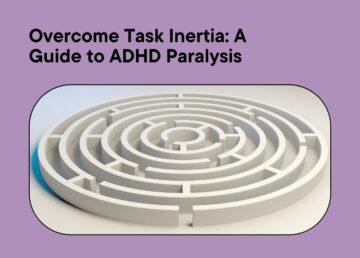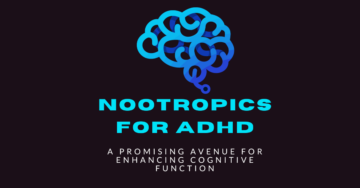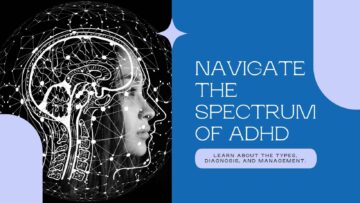
The terms attention deficit disorder (ADD) and attention deficit hyperactivity disorder (ADHD) are often used interchangeably, but there’s a catch – they mean almost the same thing.
Both acronyms represent a complex neurodevelopmental condition ADHD, though ADD is used to define inattentive ADHD.
In this comprehensive guide, we’ll delve into the nuances of the disorders, analyze ADHD vs. ADD, highlighting their differences, subtypes, symptoms, diagnosis based on the Diagnostic and Statistical Manual of Mental Disorders, and practical strategies for managing daily life.
In this article
Defining ADD and ADHD: clarity beyond acronyms
Before we get into the specifics, let’s get the terminology straight. ADHD is the umbrella term that encompasses a variety of presentations, including inattentive, hyperactive-impulsive, and combined types of ADHD.
On the other hand, ADD is not a term used in the medical community. The term was previously used to refer specifically to the inattentive type of ADHD.
However, in current medical terminology, ADD has been replaced by the broader term ADHD. This is due to updated diagnostic criteria – many individuals with inattentive ADHD also have internalized hyperactive symptoms.
What is ADHD?
Shortly, attention deficit hyperactivity disorder, or ADHD, is a neurodevelopmental disorder characterized by persistent patterns of inattention, impulsivity, and hyperactivity that interfere with daily functioning.
It affects individuals of all ages, genders, and races and can manifest in various ways. ADHD symptoms can create challenges in school, work, relationships, and overall well-being, especially if left untreated.
The confusion between ADD and ADHD
The confusion between ADD and ADHD arises from historical terminology shifts and the complexity of the condition.
The term ADHD refers to attention deficit hyperactivity disorder, while ADD – attention deficit disorder.
In the past, ADD was used to describe individuals who primarily struggled with attention-related symptoms, such as forgetfulness, lack of attention, and other difficulties with concentration.
However, modern diagnostic classifications no longer clearly distinguish between ADD and ADHD, ruling ADD as an outdated term.
Hence, using ADD and ADHD interchangeably nowadays is incorrect – it’s not ADD vs. ADHD, but rather ADHD as an umbrella term for inattentive and hyperactive-impulsive types. ADD, previously used to describe inattentive type ADHD, is considered an outdated term.
Unpacking ADHD subtypes
Attention deficit hyperactivity disorder, as the name suggests, primarily causes issues with hyperactivity and attention.
However, most likely based on genetics and environmental factors to which a person with ADHD has been exposed, the disorder manifests in three primary subtypes: inattentive (formerly known as attention deficit disorder, or ADD), hyperactive-impulsive, and combined.
Each subtype has distinct characteristics and symptom profiles, but all fall under the umbrella term ADHD.
Inattentive ADHD: when focus falters
Individuals with inattentive ADHD struggle primarily with maintaining focus and sustaining attention. They might not be as hyperactive or impulsive, but research shows these symptoms can be internalized and manifest as anxiety, especially in women.
People with inattentive type ADHD may appear dreamy, as if living in their own world, forgetful, and disorganized. Tasks that require prolonged mental effort and sustained concentration can become particularly challenging.
School or work assignments may often go unfinished due to difficulty focusing on details.
Hyperactive-impulsive ADHD: energy uncontained
High energy levels, impulsive actions, and difficulties in self-regulation characterize hyperactive-impulsive ADHD.
People with this subtype may find it challenging to sit still, feel the need to constantly fidget, tap their feet, or play with hair or other objects.
Impulsivity can lead to hasty decisions and a tendency to blurt out thoughts without considering consequences.
Combined type ADHD: a mixed presentation
Combined type is the most common presentation, where individuals experience a combination of inattentive, hyperactive, and impulsive symptoms.
They struggle with focus, exhibit restlessness, and engage in impulsive behaviors. This combination of symptoms can significantly impact various areas of their lives, from academic performance to social interactions.
Recognizing the symptoms: a guide to self-identification
Recognizing the symptoms of ADHD despite its type is the first step toward understanding and managing the condition.
While attention deficit hyperactivity disorder cannot be cured, the American Psychiatric Association (APA) suggests that both hyperactive and inattentive ADHD can be effectively managed in both children and adults.
The most common approach to treating ADHD is a combination of behavioral therapy and medication. However, to find the best treatment, it’s vital to properly evaluate individual symptoms and look at any possible comorbidities that often accompany ADHD.
Here are the primary symptoms of each ADHD type:
Symptoms of inattentive ADHD
Predominantly inattentive presentation of ADHD can include:
- Difficulty sustaining attention
- Making careless mistakes
- Being forgetful in daily activities
- Struggling with organization
Individuals might also frequently lose important items or appear to be daydreaming during conversations.
Symptoms of hyperactive-impulsive ADHD
Hyperactive-Impulsive ADHD symptoms often manifest as:
- Constant restlessness
- Impulsivity
- Difficulty waiting for turns
- Interrupting conversations
These individuals may struggle with following instructions and engaging in tasks that require sustained focus. People with predominantly hyperactive-impulsive presentations can often feel bored.
Symptoms of the combined type ADHD
Combined type ADHD combines both hyperactive-impulsive and inattentive symptoms.
People with this type of ADHD may struggle with a broad range of challenges, from forgetfulness to impulsivity, making daily tasks and responsibilities particularly demanding.
Research suggests that combined type ADHD is the most prevalent type, being 62% of all adult ADHD cases.

Getting a diagnosis: how is ADHD identified?
While many people live their whole lives with undiagnosed attention deficit hyperactivity disorder, seeking a professional diagnosis can benefit some.
If attention deficit disorder impairs your daily functioning and other areas of life, it’s crucial to reach out to mental health professionals to diagnose ADHD or other mental disorders.
A mental health professional can provide a personal treatment plan and prescribe ADHD medications, if necessary, to help you manage this disorder effectively.
Professional diagnosis
A mental health professional, often a psychiatrist or psychologist, evaluates an individual’s symptoms, medical history, and behavior patterns to determine if ADHD is present.
Observations from different settings, such as home and school, are essential for an accurate assessment.
Diagnostic criteria for ADHD
The Diagnostic and Statistical Manual of Mental Disorders (DSM-5) created by the American Psychiatric Association (APA) outlines the criteria for diagnosing ADHD.
These criteria include specific signs that must be present for a particular duration and degree of impairment, such as the following symptoms:
- Six or more symptoms of inattention. These could be: not paying attention to details, making careless mistakes, difficulty maintaining attention in tasks, disinterest when spoken to, forgetfulness in daily activities, and being easily distracted by external stimuli.
- Six or more symptoms of hyperactivity-impulsivity. For example, trouble waiting for one’s turn to act or speak, trouble listening to and paying attention to directions, talking excessively, fidgeting, and difficulty staying still.
- Symptoms across multiple settings. To rule out situational factors, the inattentive symptoms should be present in two or more settings, such as home, school, or work.
- Symptoms interfere with functioning. The inattentiveness must lead to impairment in academic, occupational, social, or day-to-day activities, affecting the person’s ability to meet their potential.
Inattention symptoms are crucial when diagnosing the predominantly inattentive type of ADHD, while hyperactivity-impulsivity is studied when diagnosing the predominantly hyperactive-impulsive type.
In the case of combined presentation ADHD, the hyperactivity component is analyzed alongside inattentiveness.
Living with ADHD: practical coping strategies
Living with ADHD presents challenges, but practical strategies can help individuals manage their symptoms and thrive.
The strategies may vary based on the individual’s age, personality traits, attention deficit hyperactivity disorder (ADHD) type, severity of symptoms, and general mental health condition.
Centers for Disease Control and Prevention (CDC) advises using the criteria defined in the
Diagnostic and Statistical Manual (DSM-5) by the American Psychiatric Association (APA) to manage the inattentive type ADHD successfully.
Strategies for children and teens
A child’s symptoms might differ from those in adults, as certain behaviors are learned with age.
Child psychologists at the Centers for Disease Control and Prevention suggest doing parent training in behavior management for parents of preschool children with ADHD.
- Monitoring a child’s behavior, identifying potential risks and challenges, and applying reward systems for positive behavior in classroom settings and at home.
- Children and teenagers with ADHD can benefit from structured routines, clear expectations, and positive reinforcement (behavioral interventions). Teaching organizational skills and encouraging self-awareness can empower them to navigate academic and social demands.
If behavioral management does not provide wanted results, healthcare professionals can administer medication for children with ADHD to help cope with inattentive and hyperactive-impulsive type of ADHD.
Strategies for adults
Adults with an inattentive type of ADHD can benefit from adopting various strategies and tools to counteract attention deficit disorder (ADD) symptoms.
- Creating to-do lists. People with predominantly inattentive presentations tend to struggle with the organization of tasks. A visible list of activities can help you remember, prioritize, and stay concentrated.
- Setting reminders. Inattentive type ADHD makes individuals lose focus, especially on tedious tasks. Scheduled reminders, such as calendar events, can help with remembering and paying attention to the tasks at hand.
- Breaking tasks into smaller steps. Those with a predominantly inattentive type can become overwhelmed by many assignments due to the inability to concentrate. To simplify the process of work, break tasks into smaller projects. This can help maintain productivity and prevent getting easily distracted.
Additionally, organizational tools, healthy coping techniques, time management techniques, virtual assistants or apps, like Sensa, and seeking help from medical professionals can aid in managing responsibilities and achieving personal and career goals.
While the inattentive type can be successfully managed with behavior therapy, some people might need additional assistance. Mental health specialists can prescribe stimulant or non-stimulant drugs to improve focus and reduce distractibility.
Understanding and navigating your ADHD journey
Understanding the nuances of ADHD, its inattentive presentation, and other subtypes empowers individuals to embark on self-discovery and effective ADHD management.
By recognizing symptoms in their own or their child’s behavior, seeking professional guidance, and adopting tailored strategies, individuals can begin to treat their ADHD and navigate their way to a full and productive life.
With the right tools and support, both adults and children with ADHD can transform mishaps into opportunities for growth and personal development.
Frequently Asked Questions
Why is ADD no longer a diagnosis?
The Diagnostic and Statistical Manual of Mental Disorders (DSM-5), the primary classification tool for mental health conditions, no longer includes the term “ADD” as a specific diagnosis. Instead, it encompasses all presentations of ADHD under one umbrella term, “Attention Deficit Hyperactivity Disorder” (ADHD). This decision was based on research indicating that there is no clear distinction between individuals with ADHD without hyperactivity and those with both hyperactivity and inattention. Both presentations share the same core symptoms and underlying neurological differences.
The DSM-5 classification system recognizes three subtypes of ADHD:
- Predominantly Inattentive Presentation: Individuals with this subtype primarily exhibit symptoms of inattention, such as difficulty focusing, daydreaming, and disorganization.
- Predominantly Hyperactive/Impulsive Presentation: Individuals with this subtype primarily exhibit symptoms of hyperactivity and impulsivity, such as restlessness, fidgeting, difficulty staying still, and blurting out responses.
- Combined Presentation: Individuals with this subtype exhibit symptoms of inattention, hyperactivity, and impulsivity.
This change in classification reflects a growing understanding of ADHD’s spectrum of presentations and the shared underlying mechanisms across subtypes. It also aims to reduce stigma and misconceptions associated with the term “ADD.”
How do I know if I’m ADD or ADHD?
Determining whether you have ADHD or ADD can be challenging, as the symptoms can overlap with other conditions and vary greatly from person to person. However, there are some key indicators that may suggest you have ADHD.
First, consider the duration of your symptoms. If you’ve experienced persistent difficulties with attention, focus, hyperactivity, or impulsivity since childhood or adolescence, it’s worth considering ADHD. These symptoms should not be solely attributed to external factors, such as stress or anxiety, and should significantly interfere with your daily life.
Second, assess the severity of your symptoms. If your struggles with attention, focus, or organization significantly impact your academic performance, job productivity, or personal relationships, it’s important to seek professional evaluation.
Third, consider the frequency of your symptoms. If you experience these challenges on a regular basis, even in situations where you’re interested or engaged, it’s more likely that they’re related to ADHD rather than occasional lapses in concentration.
If you’re concerned about having ADHD or ADD, it’s crucial to consult with a healthcare professional, such as a psychiatrist, psychologist, or pediatrician. They can conduct a thorough evaluation to determine whether you meet the diagnostic criteria for ADHD and, if so, recommend appropriate treatment options.
Remember, ADHD is a treatable condition, and with appropriate support, you can manage your symptoms, improve your functioning, and achieve your goals.
Was ADD changed to ADHD?
Yes, the term “ADD” was changed to “ADHD” in the fifth edition of the Diagnostic and Statistical Manual of Mental Disorders (DSM-5), which was published in 2013. The DSM-5 is the standard reference for mental health diagnoses in the United States.
The change from ADD to ADHD was made to emphasize that all presentations of the disorder, including those that do not involve hyperactivity, are due to the same underlying neurological differences. The term “ADD” was seen as potentially misleading, as it could suggest that there is a distinct subtype of ADHD that is characterized only by inattention.
The DSM-5 recognizes three subtypes of ADHD:
- Predominantly Inattentive Presentation: Individuals with this subtype primarily exhibit symptoms of inattention, such as difficulty focusing, daydreaming, and disorganization.
- Predominantly Hyperactive/Impulsive Presentation: Individuals with this subtype primarily exhibit symptoms of hyperactivity and impulsivity, such as restlessness, fidgeting, difficulty staying still, and blurting out responses.
- Combined Presentation: Individuals with this subtype exhibit symptoms of inattention, hyperactivity, and impulsivity.
Despite the change in terminology, the diagnostic criteria for ADHD remain essentially the same. If you were diagnosed with ADD before the DSM-5 was published, your diagnosis would now be considered ADHD, specifically the subtype that best describes your symptoms.
What is ADD like behavior?
Attention deficit disorder (ADD), now more commonly referred to as attention deficit hyperactivity disorder (ADHD), is a neurodevelopmental disorder that affects people’s ability to focus, manage attention, and control impulses. While the term “ADD” is no longer officially used in the diagnostic criteria, it can still be used colloquially to describe the inattentive presentation of ADHD.
Individuals with ADD-like behavior may exhibit a range of symptoms that impact their daily life. These symptoms can include:
- Difficulty concentrating: They may find it challenging to stay focused on tasks, especially ones that are not inherently stimulating or interesting.
- Daydreaming or mind wandering: They may frequently lose focus and drift off into their thoughts, making it difficult to follow instructions or complete tasks.
- Disorganization and forgetfulness: They may struggle with organizing tasks, managing time effectively, and remembering important details.
- Procrastination and avoidance: They may delay or avoid tasks that require sustained focus, leading to missed deadlines and increased stress.
- Misplacing items and losing track of belongings: They may frequently misplace their belongings, such as keys, phones, or important documents.
- Overstimulation in noisy or crowded environments: They may be easily overwhelmed by sensory input and have difficulty focusing in noisy or crowded places.
- Difficulties following instructions or completing tasks: They may struggle to follow instructions or complete tasks due to distractibility and focus issues.
- Poor time management: They may have difficulty estimating time accurately and managing time effectively.
- Difficulty listening to others: They may struggle to concentrate on conversations, remember what others have said, and follow instructions.
While these behaviors can be challenging to manage, there are effective treatments available. With appropriate support, individuals with ADD-like behavior can learn strategies to improve their focus, organization, and impulse control, enabling them to thrive academically, professionally, and personally.
References:
- Carr, L., Henderson, J. and Nigg, J.T., 2010. Cognitive control and attentional selection in adolescents with ADHD versus ADD. Journal of Clinical Child & Adolescent Psychology, 39(6), pp.726-740.
- Brown, T.E. and Nadeau, K.G., 1995. Differential diagnosis of ADD versus ADHD in adults. A comprehensive guide to attention deficit disorder in adults: Research, diagnosis, and treatment, pp.93-108.
- Bluschke, A., Chmielewski, W.X., Mückschel, M., Roessner, V. and Beste, C., 2017. Neuronal intra-individual variability masks response selection differences between ADHD subtypes—A need to change perspectives. Frontiers in Human Neuroscience, 11, p.329.
- Kuperman, S., Johnson, B., Arndt, S., Lindgren, S. and Wolraich, M., 1996. Quantitative EEG differences in a nonclinical sample of children with ADHD and undifferentiated ADD. Journal of the American Academy of Child & Adolescent Psychiatry, 35(8), pp.1009-1017.
- Hesslinger, B., Thiel, T., Van Elst, L.T., Hennig, J. and Ebert, D., 2001. Attention-deficit disorder in adults with or without hyperactivity: where is the difference? A study in humans using short echo 1H-magnetic resonance spectroscopy. Neuroscience letters, 304(1-2), pp.117-119.




